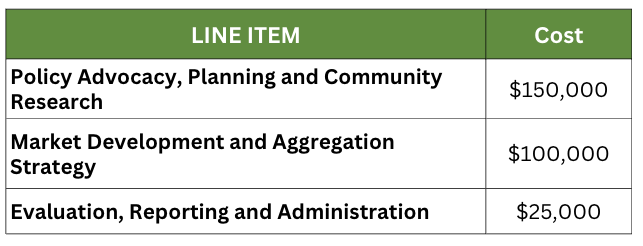
Find resources right for you.
The Food Systems Work Group seeks to strengthen Maui County’s food systems by investing in local producers and regional infrastructure to improve food security, drive economic diversification, and build long-term community resilience. The initiative focuses on supporting small and mid-sized producers and expanding value-added production pathways that foster local ownership and profitability.
Maui County imports an estimated 85-90% of its food, making the region highly vulnerable to supply chain disruptions, rising costs, and climate-related shocks. Despite this, small and mid-sized producers face persistent barriers to scaling production and accessing markets- limiting their ability to meet local demand and compete with imports.
In close partnership with farmers, ranchers, fishers, and food businesses, the initiative addresses critical gaps in production, distribution, and market coordination. The initiative will prioritize sustainable land stewardship, culturally grounded agricultural practices, and equitable access to local markets- especially for Native Hawaiian communities and small-scale operators. This work directly advances the Maui County Food & Nutrition Security Plan by building food supply chains that are both community-rooted and economically viable.
To address structural barriers, the Taskforce will lead targeted systems-level interventions- identifying and implementing solutions to inter- and intra-island shipping challenges; expanding institutional market access through digital planning tools and coordinated procurement; supporting the development of shared infrastructure such as cold storage and protein processing facilities; and deploying direct investments- such as protein subsidies and capacity-building grants- to stabilize and scale local operations.
These efforts build on proven programs and trusted partnerships already active in Maui County- from mobile markets and food-as-medicine initiatives to regenerative ranching and over a decade of food systems organizing. Led by a coalition of local producers, community-based organizations, and policy advocates- including Hawai‘i Farmers Union, with its grassroots base supported by state and national reach through the National Farmers Union- this initiative advances a shared vision: a resilient, locally controlled food economy rooted in community knowledge, cultural integrity, and long-term sustainability.
This project directly aligns with several Maui County priorities, including the Maui Recovery Framework, the County’s Climate Action and Resiliency Plan, and the Countyʻs Food Security Action Plan. It supports the goals of economic diversification, environmental sustainability, disaster resilience, and increased self-sufficiency.
Phase 1: Groundwork & Policy Development (Current)
This phase lays the foundation for long-term systems change by leveraging the team’s existing networks, identifying systemic barriers, and shaping a unified policy agenda.
Phase 2: Direct Investment & Pilot Programs (Future)
Building on the groundwork of Phase 1, this phase will test targeted strategies and deliver early-stage investments to strengthen local production and prepare for long-term systems transformation.
Potential activities include:
Phase 3: Infrastructure Buildout & Market Integration (Future)
Informed by pilot outcomes and adopted policies, this phase would scale successful strategies to embed local food into regional systems and ensure long-term sustainability.

Total: $275,000